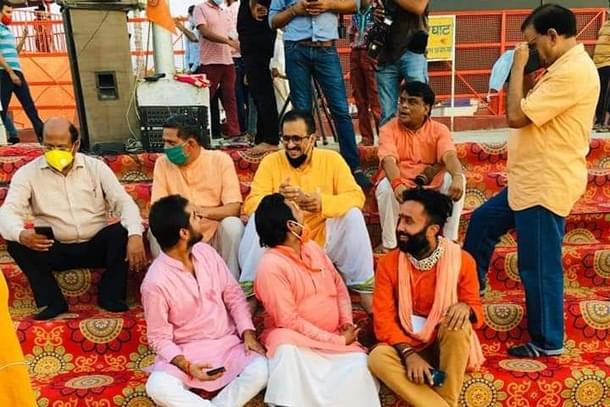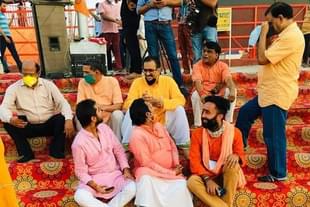Politics
Their Forefathers Gave Up Wearing Turbans After Losing Ram Janmabhoomi To Mughal Control; 500 Years Later, This Community In Ayodhya Is Set To Don Its Headgear Again
Sumati Mehrishi
Aug 09, 2020, 10:08 AM | Updated 10:08 AM IST
Save & read from anywhere!
Bookmark stories for easy access on any device or the Swarajya app.


On 5 August, as the bhoomi pujan ceremony of Shri Ram Mandir in Ayodhya progressed, members of Ayodhya's Suryavanshi Kshatriya community, who live in villages on both sides of the Saryu river, erupted in tears.
For them, it was a swirling clash of several emotions. The first time, when they saw on television screens PM Modi and Yogi Adityanath offering prayers at Hanuman Garhi mandir; moments later, when they saw the two leaders fighting with their own emotion at the Ram Mandir bhoomi pujan.
The burden of the past was slowly slipping away.
Ayodhya's Suryavanshi Kshatriyas consider themselves the descendants of Ram, and defendants of the Ram janmabhoomi, and Ayodhya. They refer to Ram as Raja. Raja Ram.
Five centuries ago, their courageous Ram-bhakta forefathers from the Suryavanshi Kshatriya clan took a vow — to not wear turbans. This happened after they faced defeat from the Mughal armies over temple control.
The man spearheading the defensive and offensive against the Mughals is said to be Thakur Gajsingh.
The Suryavanshi Kshatriya set a spiritual milestone to wearing the turban. Mahendra Pratap, a member of the community living in a village in Ayodhya explains the vow to this author: "Our poorvaj decided to refuse the use of turbans. They took a vow — that they won't wear it — until the day they win back the Ram janmabhoomi and its dignity from the clutches of the aggressor — the Mughal armies".
The five century long-separation from the turban
Pratap says that the Suryavanshi Kshatriya clan gave up the use of these symbols and objects simply because they could not bear what the defeat would lead to: losing the control of Ram's birthplace, and the temple, to the enemy.
Pratap adds, "Our clan has even given up the use of chhatri (the traditional umbrella) that protects us from heat."
Khadhau made of wood replaced leather footwear. Gamchha or the mauri — that keeps the head bare — replaced the turban.
"People of the older generations did not even use a gamchha. And women of our community, even today, won't use the chhatri," adds Pratap.
Adding to the inherent pain in the Suryavanshi Kshatriyas' oral narrative, was the community's own remorse.
The result of the defeat, as per the clan's narrative, brought the spirits to the ground.
The killing of people from villages that lie on both sides of the Saryu river by the Mughals was soul-wrenching.
But the courage remained unwavering and blooded.
"Hamare poorvaj balwaan thhe," Sheetla Singh, another elderly member of the community, told Swarajya.
Over centuries that followed, the vow hardened, kept and followed by generations, because the challenges to the sanctity of Ram janmabhoomi, would not subside.
The refusal of tangible symbols of the past became part of their identity.
The ending of a vow
Today, the men of the community consider nothing as painful as seeing Ram Lalla placed under a makeshift tent.
Pratap broke down over the phone a few times as his told this author: "I cannot tell you about the pain we have lived in for years — watching our aaradhya Shri Ram living under a tent — while we lived in pucca houses. This is our weakness — the collective weakness of the Hindus."
It was a reminder of the tearing sense of helplessness that the forefathers had gone through at the hands of the aggressor five centuries ago.
"Hum Ram ko mool sthaan nahin de paaye itne samay tak (we couldn't win for Ram his own place for so, so long)," he adds.
The many layers of the turban's return
Three days have passed since the bhoomi pujan.
Ramayana paatth (the reading of Ramayana), Sundarkaand paatth (the reading of Sundarkaand), rangolis in and outside houses, distribution of prasad and sweets across Ayodhya, have been their quick and easy expression of happiness.
The singing of bhajans, the flying patakas (celebratory flags dedicated to Ram and Hanuman) in houses across Ayodhya, the lighting of lamps, have marked the celebrations following the bhumi pujan. But the men of the Suryavanshi Kshatriya community, still, are using the gamchha instead of the crisp, full flowing and the proud turban, (as evident in the celebration pictures sent by Pratap).
After the historic Supreme Court verdict in 2019, men from the community distributed turbans and organised meetings to boost the distribution of turbans in 105 villages.
Today, they are meeting elders and people from the community, visiting Dasrath samadhi sthhal at the banks of Saryu.
The headgear hasn't switched — from the gamchha or mauri to turban. To accept the turban would be an emotionally therapeutic process into rejecting the pain of community histories, men of the community feel.
"Pehenenge, pagdi aur saafaa pehnenge. The bhoomi pujan has culminated. The construction will begin. Wearing the turban will give the community closure. Let the construction begin, the turban will come back," Sheetla Singh adds.
Notice how the event — that of the wearing of the turban — is now getting new milestones, newer milestones.
The long legal battle for Ram janmabhoomi has clearly sapped their spirits. The emotion of closure is palpable.
The refusal to wear the turban is now chipping away, and melting.
However, in the new spiritual and cultural dawn for this community, there seems, still, a lot of hesitation for picking the turban.
When this author spoke to Ramesh Singh, another member of the Suryavanshi Kshatriya community in Ayodhya, he was supervising the work of packing 350,000 laddoo packets to be distributed across Ayodhya.
One won't expect him to betray a sense of fear — of being thrown back to the ateet — the past. What if. What if the past returns. Or returns the aggressor.
Ramesh Singh said: "All we have to ensure is that we do not go back to the past."
Pratap did not mince words. "We are a fortunate generation to be living and witnessing the bhoomi pujan and this is happening in the presence of PM Modi and CM Yogi Adityanath. They have not shied away from touching issues that others did not want to touch. We fumble one more time, and we won't get a chance for correction," he added.
Kshatriya for karseva and karsevaks
People of the community had never expected to see in Ayodhya — after the violence-torn karseva of the 1990s — a culmination of caste diversities for dharm for Ram, Ram janmabhumi and Ayodhya.
The bhoomi pujan provided that amalgamation.
In 1990, people of the Suryavanshi Kshatriya community took the responsibility of hosting karsevaks from across India. Among the karsevaks were people from the southern states "Karnataka and Andhra Pradesh (then)", Sheetla Singh points out.
Sheetla Singh told this author that the men of their community turned Ayodhya into a home for the karsevaks in the 1990s.
The karsevaks coming from Gonda and Basti would be taken care of in the terai area and many, who came out safely from the police firing in 1990, and the ensuing events, were seen off, most carefully and warmly by the villagers of all castes.
He says, "Karsevaks from outside Ayodhya were unaware of the routes and the nitty-gritties of Ayodhya lanes. They needed to be helped with the way towards the temple through the routes from the banks of the river."
Pratap himself was 15-16 years old in 1990.
It was the year when the police received orders to open fire at the karsevaks.
In 1990, Pratap joined members of his community living in the villages in Ayodhya, people of other castes living in the villages, and hundreds of unknown karsevaks in a march that would be disrupted by violence.
The youth among them were guided by the elders from the Suryavanshi Kshatriya community, and elders from other castes to strengthen the karseva.
Things could become ugly anytime, they feared, but they were concerned about the karsevaks from outside Ayodhya, especially folks from other states.
Pratap recalls: "We had the advantage of familiarity. We knew the lanes of Ayodhya. Eventually, things did turn violent — with the police firing. Unfortunately, karsevaks from outside of Ayodhya suffered more."
After a pause he adds, "I remember seeing people jumping into the river to save themselves. I remember seeing so many slippers and shoes lying on the bridge."
Stand on Hindu unity or fall on caste differences
Hindus could fumble once again by getting divided by caste, believe the members of the Suryavanshi Kshatriaya Samaj.
"Jaati, upp-jaati, bas Hindu hee batata hai. Aur koi nahin. This must end," they add.
Adityanath and PM Modi, together leading the ceremonies and the historic moment, reminded them of their forefathers and people of other castes who had fought together to preserve the sanctity of Ram Janmabhoomi over the centuries, they say.
Roving within it, the Suryavanshi Kshatriya community, saw another reflection — that of the confluence and a unifying force they had witnessed during the movement in 1990.
The members of the community would wash the feet of the karsevaks, and even give them refuge at home.
"We did all that we could," they say. "That we are alive to witness the bhoomi poojan and a new beginning, is our saubhagya. Bahut saari peedhiyaan mar khap gayee is din ki dekhne ke liye," Pratap concludes.
Ayodhya's Suryavanshi Kshatriya is calling for Hindu unity, but is not quick to wear his own turban.
Hindu pride emanating from Ram Mandir is collective, and understanding the new phase, from the Suryavanshi Kshatriya's point of view, important.
If a special ceremony prods men of the community into wearing the turban again — layer by fold and round — five centuries after their forefathers took the resilient vow, it would be worth our collective celebration.




